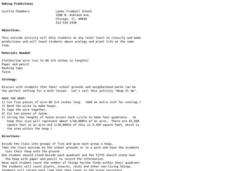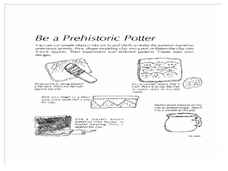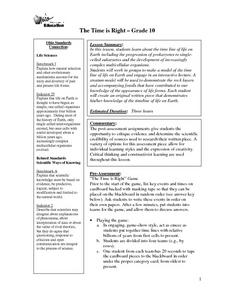Curated OER
Kinds of Volcanic Eruptions
In this volcanic eruption worksheet, students will read descriptive information about four types of volcanic eruptions: Hawaiian, Strombolian, Vulcanian, and Pelcean. Then students will identify 4 figures of eruptions as one of these...
Curated OER
Tequila's New Sunrise
In this editing/proofreading worksheet, 5th graders read and proofread the text "Tequila's New Sunrise" for spelling mistakes. Students correct each spelling mistake they find.
Curated OER
Making Predictions
Students collect and classify items. For this making predictions lesson, students go outside and collect specimens of plants, insects and minerals. They classify each item and place them in a Venn Diagram. Students compare and contrast...
Curated OER
Avalanches--Beautiful and Awe Inspiring
Avalanche lesson plans can help students learn about this interesting natural phenomena.
Curated OER
Weathering Rates
Students calculate weathering rates from tombstone weathering data. Atmospheric (and precipitation) chemistry determines the rate of weathering for marble tombstones. They are shown data from a rural and an unrban cemetery, and are...
Curated OER
Fracture Fundamentals: A Cheesy Analog
Students make small cuts (fracture nuclei) in processed cheese food and then apply stresses perpendicular or parallel to the cuts to see how fractures grow. They make predictions before each experiment and explain their results to the...
Curated OER
Sorting Objects
First graders experiment with sorting. In this sorting lesson, 1st graders separate objects according to one attribute: smooth, rough, hard or soft.
Curated OER
The Extraordinary Life of the Alaskan Tundra
Students investigate the characteristics of the tundra on the North Slope of Alaska. They conduct Internet research, develop a chart of the types of vegetation, plant growth, and fauna found on the tundra, identify examples in their own...
Curated OER
Invertebrates
In this invertebrates worksheet, high schoolers read about the characteristics of the different groups of invertebrates. Then students complete 10 multiple choice questions.
Curated OER
I Wood if I Could
Tenth graders investigate the process of how specific products are made from trees. For this chemistry lesson, groups of students must choose among ice cream, bubble gum, paper, toothpaste and lipstick. They research, design and produce...
Utah LessonPlans
Water, Water Everywhere
Murals are used to represent the various ways we rely on water.
Curated OER
Classification and Attributes
Students classify objects based on their attributes. They explain how archaeologists use classification to help answer research questions.
Curated OER
Archaeology and Prehistoric Native Americans
Young scholars study the terms paleontology and archaeology and examine how they can help us learn about prehistoric Native Iowans. In this archaeology instructional activity students discuss these terms and view a video on Native...
Curated OER
It's Alive
First graders critically analyze living and nonliving objects, then develop a list of characteristics to classify objects on a science walk. They make a book to close out the lesson.
Curated OER
Classification is Sweet
Students classify, weight and organize items during this lesson. This lesson works great as or with an introduction of the Periodic Table of Elements.
Curated OER
The Time is Right
Tenth graders study the timeline of life on Earth. They learn about the progression of prokaryotes to single celled eukaryotes and the development of increasingly complex multicellular organisms.
Curated OER
To Every Thing There Is A Season...
Students use the artwork by Robert Harris to examine the four seasons. In groups, they identify the clothing worn in the artwork and create a dance which resembles the painting. They also practice reading a thermometer and identify...
Curated OER
Pitch, Intonation, Harmonic Theory
Students listen to pitches and determine if they are in tune, flat or sharp. Using Aurelia computer software and playing as a band, students practice pitch theory, and play two-octave major scales. They practice and discuss how to tune...
Curated OER
There Was an Old Lady. . .
Students alter a familiar short poem or song with synonyms and antonyms. In this synonym and antonym lesson, students replace the synonyms or antonyms in the text and discuss the changes in meaning. Students share their words.
Curated OER
Indians in Georgia: How Do We Know What We Know?
Students discover archaeology by investigating the history of Native Americans in Georgia. In this U.S. history lesson, students participate in a mock archaeological excavation in their classroom by recovering artifacts and drawings...
Curated OER
Short O and Digraph SH
First graders practice the short o and sh sound. In this phonics lesson, 1st graders listen to the stories Hot Pot: The Sound of Short O by Alice K. Flanagan and Shoes: The Sound of SH by Peg Ballard. They create word webs with examples...
Curated OER
Creating Journals
Students take a virtual tour of Yosemite and selects photographs to use in their journal.
Curated OER
Geologic Puzzles: Morrison Formation
Students make observations and present interpretations based on their observations and on their prior knowledge. They use images to answer questions and make formulate hypotheses.
Curated OER
Fossil Footsteps
Fourth graders create their own dinosaur tracks using clay. In addition, 4th graders compose a story about the dinosaur / animal who created the tracks. They study photographs of dinosaur tracks before beginning.

























